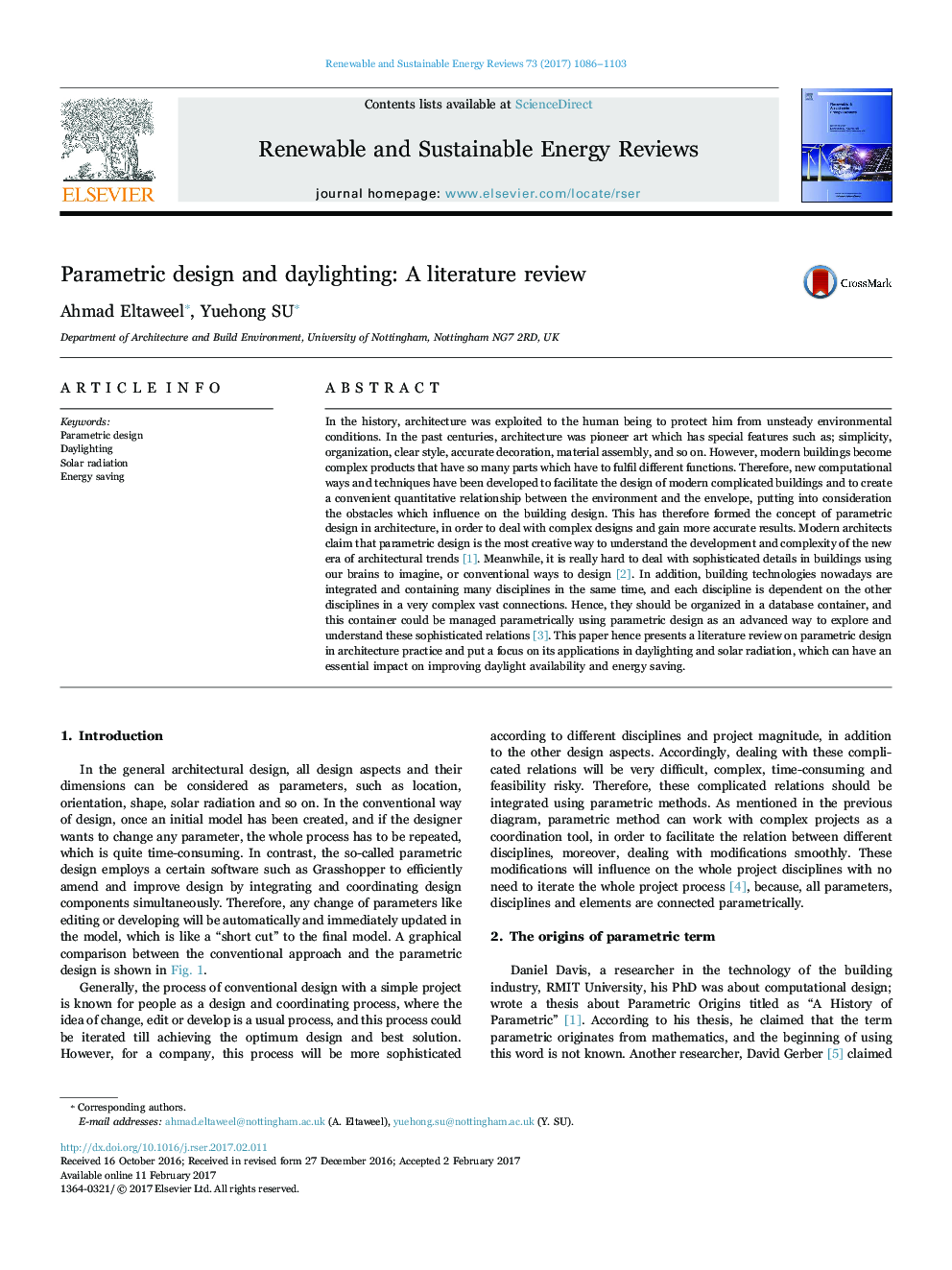| کد مقاله | کد نشریه | سال انتشار | مقاله انگلیسی | نسخه تمام متن |
|---|---|---|---|---|
| 5482322 | 1522313 | 2017 | 18 صفحه PDF | دانلود رایگان |
عنوان انگلیسی مقاله ISI
Parametric design and daylighting: A literature review
ترجمه فارسی عنوان
طراحی پارامتریک و نور روز: بررسی ادبیات
دانلود مقاله + سفارش ترجمه
دانلود مقاله ISI انگلیسی
رایگان برای ایرانیان
کلمات کلیدی
طراحی پارامتریک نور روز تابش خورشیدی، ذخیره انرژی،
ترجمه چکیده
در تاریخ، معماری به انسان مورد سوء استفاده قرار گرفت تا او را از شرایط محیطی نامطلوب محافظت کند. در قرن های گذشته معماری هنر پیشگام بود که ویژگی های خاصی دارد؛ سادگی، سازمان، سبک روشن، دکوراسیون دقیق، مونتاژ مواد و غیره. با این حال، ساختمان های مدرن محصولات پیچیده ای می شوند که دارای بخش های زیادی هستند که باید عملکرد های مختلفی را انجام دهند. بنابراین، روش های جدید و محاسباتی جدید برای تسهیل طراحی ساختمان های پیچیده پیچیده و ایجاد ارتباط مناسب کمی بین محیط و پاکت طراحی شده است، با توجه به موانعی که بر روی طراحی ساختمان تاثیر می گذارد. بنابراین، مفهوم طراحی پارامتری در معماری، به منظور مقابله با طرح های پیچیده و به دست آوردن نتایج دقیق تر، شکل گرفته است. معماران مدرن ادعا می کنند که طراحی پارامتری راه خلاق ترین راه برای درک توسعه و پیچیدگی دوران جدید معماری است [1]. در عین حال، سخت است که با جزئیات پیچیده در ساختمان هایی که از مغزهای ما استفاده می کنند تصور کنیم، یا راه های معمول برای طراحی [2]. علاوه بر این، تکنولوژی های ساختمانی در حال حاضر یکپارچه هستند و حاوی بسیاری از رشته ها در یک زمان است و هر رشته به سایر رشته ها بستگی دارد. از این رو، آنها باید در یک ظرفیت پایگاه داده سازماندهی شوند و این ظرف را می توان به صورت پارامتری با استفاده از پارامتریک طراحی به عنوان یک راه پیشرفته برای کشف و درک این روابط پیچیده [3]. در این مقاله، بررسی ادبیات در مورد طراحی پارامتری در عمل معماری ارائه شده و تمرکز بر کاربرد آن در نور روز و تابش خورشید، که می تواند تاثیر قابل توجهی در بهبود دسترسی روزافزون و صرفه جویی در انرژی داشته باشد.
موضوعات مرتبط
مهندسی و علوم پایه
مهندسی انرژی
انرژی های تجدید پذیر، توسعه پایدار و محیط زیست
چکیده انگلیسی
In the history, architecture was exploited to the human being to protect him from unsteady environmental conditions. In the past centuries, architecture was pioneer art which has special features such as; simplicity, organization, clear style, accurate decoration, material assembly, and so on. However, modern buildings become complex products that have so many parts which have to fulfil different functions. Therefore, new computational ways and techniques have been developed to facilitate the design of modern complicated buildings and to create a convenient quantitative relationship between the environment and the envelope, putting into consideration the obstacles which influence on the building design. This has therefore formed the concept of parametric design in architecture, in order to deal with complex designs and gain more accurate results. Modern architects claim that parametric design is the most creative way to understand the development and complexity of the new era of architectural trends [1]. Meanwhile, it is really hard to deal with sophisticated details in buildings using our brains to imagine, or conventional ways to design [2]. In addition, building technologies nowadays are integrated and containing many disciplines in the same time, and each discipline is dependent on the other disciplines in a very complex vast connections. Hence, they should be organized in a database container, and this container could be managed parametrically using parametric design as an advanced way to explore and understand these sophisticated relations [3]. This paper hence presents a literature review on parametric design in architecture practice and put a focus on its applications in daylighting and solar radiation, which can have an essential impact on improving daylight availability and energy saving.
ناشر
Database: Elsevier - ScienceDirect (ساینس دایرکت)
Journal: Renewable and Sustainable Energy Reviews - Volume 73, June 2017, Pages 1086-1103
Journal: Renewable and Sustainable Energy Reviews - Volume 73, June 2017, Pages 1086-1103
نویسندگان
Ahmad Eltaweel, Yuehong SU,
